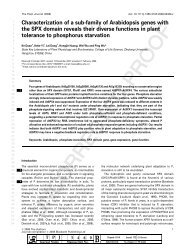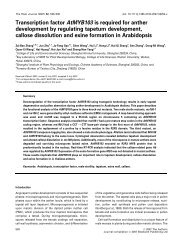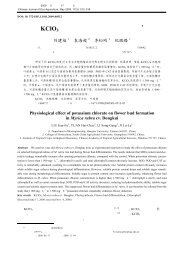Brassica campestris L. ssp. chinensis M
Brassica campestris L. ssp. chinensis M
Brassica campestris L. ssp. chinensis M
You also want an ePaper? Increase the reach of your titles
YUMPU automatically turns print PDFs into web optimized ePapers that Google loves.
interference has been adopted to repress the<br />
expression of BcMF5 by transgenic approaches.<br />
The results showed that the expression of BcMF5<br />
is depressed. Furthermore, not only did the<br />
germination ability of pollen in transgenic plants<br />
decrease, the resulting pollen was also found to be<br />
abnormal with a collapsed germination furrow.<br />
Furthermore, PCPs have been shown to originate<br />
from the tapetum, a specialized layer of cells that<br />
line the anther locule, but act in a gametic manner<br />
(Heslop-Harrison, 1967, 1968; Dickinson and Lewis,<br />
1973a, b; Heslop-Harrison et al., 1973). The tapetum<br />
serves a nutritive function during microsporogenesis<br />
and provides most of the precursors<br />
necessary for the synthesis of the tough sporopollenin,<br />
the outer wall of the pollen grain, the exine<br />
(Doughty et al., 2000). Because the tapetum is<br />
sporophytic, such male-sterile mutants generally<br />
are recessive and all of the pollen grains within an<br />
anther are affected (McCormick, 2004). The A9<br />
promoter used in this paper is a tapetum-specific<br />
promoter identified from Arabidopsis thaliana (Paul<br />
et al., 1992). Thus, it is rational that all pollen of<br />
transgenic plants should be affected. In this paper,<br />
the percentage of abnormal pollen was recorded at<br />
88.37% and close to 100%. This is likely because the<br />
expression of BcMF5 is not wholly inhibited by RNA<br />
interference, which is consistent with 38.74% of<br />
pollen germination. This also illustrated that the<br />
ARTICLE IN PRESS<br />
Functional analysis of a novel PCP gene BcMF5 453<br />
Figure 7. Morphological comparison of the pollen between transgenic and non-transgenic flowering Chinese cabbage<br />
by scanning electron microscope. (A) pollen of non-transgenic plant at a magnitude of 2000 times; (B) pollen of the<br />
transgenic line at a magnitude of 500 times; and (C) pollen of the transgenic line at a magnitude of 2000 times.<br />
Table 2. Abnormal pollen percentage of pBIA9-RMF5, using a scanning electron microscope<br />
Types of plantlets Total no. of pollen<br />
(pellet)<br />
No. of abonormal pollen<br />
(pellet)<br />
Percentage of abonormal<br />
pollen<br />
WT 282 24 7.972.4<br />
pBIA9-RMF5 402 354 88.3775.32<br />
The data in the table are means7SD from four measurements.<br />
expression of BcMF5 has a close relation to the<br />
tapetum.<br />
A promoter has a significant effect on the<br />
location, timing, and strength of gene expression,<br />
and the expression analysis of the promoter<br />
contributes to the understanding of gene function.<br />
The BcMF5 promoter began to express in the early<br />
stage of anther development (Figure 8B) and drove<br />
high levels of GUS expression in anthers, pollen,<br />
and pollen tube in the late stage of pollen<br />
development (Figure 8C–G). Although BcMF5 shares<br />
a high homology to SLR1-BP, the expression pattern<br />
of BcMF5 was different from that of SLR1-BP. An<br />
RNA gel blot analysis showed that high levels of<br />
SLR1-BP mRNA were detected only in anthers at the<br />
late developmental stages. Moreover, in situ<br />
hybridization also showed that the antisense probe<br />
of SLR1-BP hybridized only to the cytosol of the<br />
microspores and not to any sporophytic tissue of<br />
the anther (Takayama et al., 2000a). This showed a<br />
strictly gametophytic expression manner. In contrast,<br />
the expression profile of BcMF5 and its<br />
promoter (Figures 3 and 8) seemed to show a<br />
sporophytic or gametophytic expression pattern,<br />
which is similar to SP11. The SP11 gene is the sole<br />
male determinant in the self-incompatibility of the<br />
<strong>Brassica</strong> species (Schopfer et al., 1999; Shiba et al.,<br />
2001). It is also specifically expressed in the tapetal<br />
cell of the anther at the early developmental








